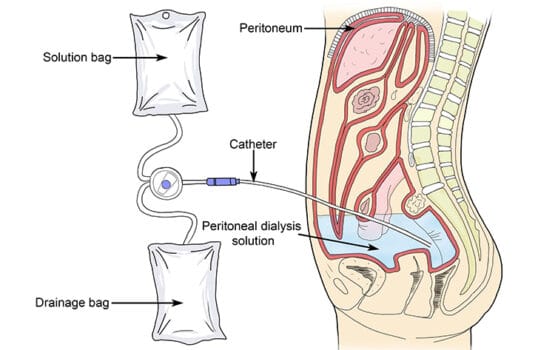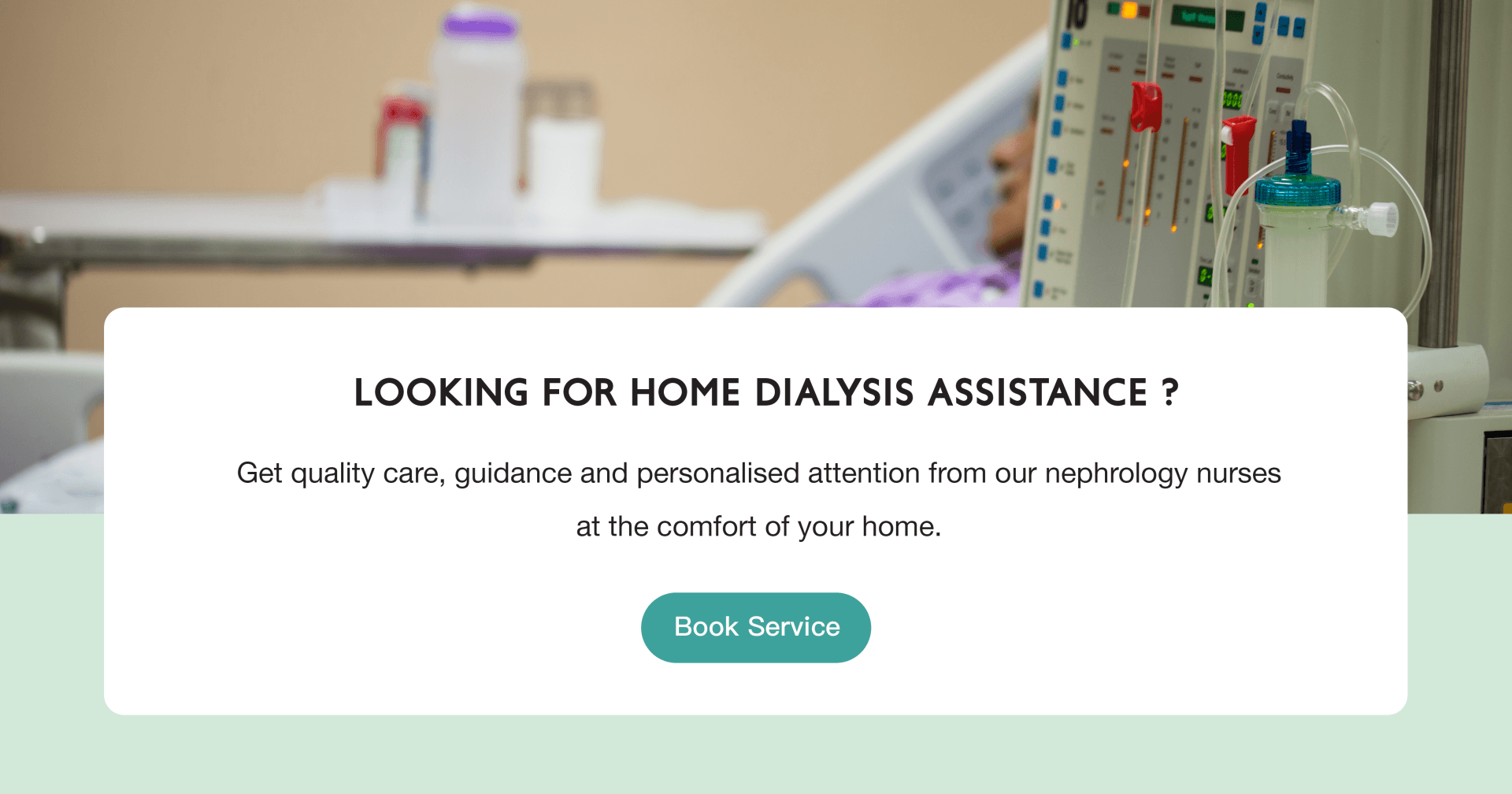Peritoneal dialysis (PD) is one way for patients with kidney failure to substitute the function of a kidney. PD machines are easy to carry and use, making PD at home a popular choice of treatment among patients. Because kidneys are fragile, it is important for caregivers to take great care and caution when assisting patients with PD treatments.
Peritoneal dialysis (PD) is a common treatment for patients with renal failure. Most patients go through PD whilst waiting for a kidney donation, or as a permanent kidney substitution. With PD, waste, excess salt and water are filtered through a membrane in the abdomen called the peritoneum and drained out using a dialysate, which is an electrolyte solution that is introduced into the body to help clean waste.
There are two main types of peritoneal dialysis, namely continuous ambulatory peritoneal dialysis (CAPD) and automated peritoneal dialysis (APD). Both can be done at home. Patients using CAPD must drain their dialysate manually three to four times a day. On the other hand, those using APD only have to set up the APD machine before going to bed, and the machine will automatically perform PD exchanges 4-5 times throughout the night. Before commencing PD treatment, patients should first undergo PD catheter placement surgery, in order to connect their kidneys to the external PD machine.
1. What are the steps to at-home peritoneal dialysis?
2. What are some side effects and complications that might arise from peritoneal dialysis?
1. What are the steps to at-home peritoneal dialysis?
Before PD:
Patients or caregivers should first sanitise their surroundings with alcohol and wash their hands to ensure proper hygiene. PD equipment and dialysate should also be checked and maintained. Make sure to lightly press the packet of dialysate before using, to ensure that there are no leakages.
During PD:
Every time a patient undergoes CAPD, they have to first fill up their abdominal cavity with around two litres of dialysate through their PD catheter (actual volume of dialysate will depend on the capacity of the patient’s abdominal cavity). This process will last around 20 to 30 minutes. Dialysate can remain in the abdominal cavity for 4 to 8 hours a day, and up to 10 hours at night. Patients should not feel any discomfort during CAPD, and should be able to perform normal daily activities. Dialysate has to be drained out manually after one cycle of CAPD, with the drainage process lasting 20 to 30 minutes.
If the patient has opted for APD, treatment can happen at night. All the patient needs to do is remove the APD machine from their catheter when they wake up in the morning. APD is further divided into two types: Continuous Cyclic Peritoneal Dialysis (CCPD) and Nightly Intermittent Peritoneal Dialysis (NIPD). Their only difference lies in whether or not the dialysate remains in the abdominal cavity in order for PD to continue throughout the day.
Note that typically glucose dialysate should not remain in the abdominal cavity for less than 4 hours, as it requires that amount of time for its treatment effects to occur. It should also not remain in the abdominal cavity for more than 10 hours, as the effects of PD would have been fully exhausted by that time. Moreover, the dehydration effects would be offset, causing excess water build up. In addition, caregivers should pay attention to the glucose concentration of the dialysate. Doctors will choose dialysate with different levels of concentration based on the patient’s fluid balance and the physiological properties of their peritoneum. The higher the concentration, the greater the rate of dehydration. The highest level of glucose concentration available (4.25%) has effective filtration abilities, but should not be used extensively or improperly. The doctor’s instructions must also be followed in great detail.
After PD:
Be sure to check the condition of the dialysate after drainage. If the dialysate appears murky, it could be a sign of peritoneal infection, in which case the patient should consult a doctor immediately.
Things to note:
Highly concentrated dialysate has a high sugar content which might raise the blood sugar levels of the patient, and should therefore be accompanied by insulin injections to control blood sugar levels. Moreover, sugar in dialysate may lead patients to feel full even when they have not eaten much. It is important for patients to eat enough even if they do not feel hungry, so they do not lack the necessary nutrients for building immunity and disease control.
2. What are some side effects and complications that might arise from peritoneal dialysis?
PD leads to a wide variety of side effects, including low blood pressure, skin irritation, fatigue and sleep problems. The main complication of PD is peritoneal infection, which happens when bacteria enters the abdominal cavity through the PD catheter. Murky dialysate drainage, fever and abdominal pain are all possible symptoms of peritoneal infection, and patients should consult a doctor if they display these symptoms. Treatment for peritoneal infection involves oral medication and lasts over 14 days, and does not require hospital stay.
In order to prevent peritoneal infection, patients must follow a strict procedure when it comes to the PD exchange, and ensure everything is clean and sterile. Washing hands and cleaning surroundings before a PD session is key. If needed, caregivers of patients may close doors and windows and turn off the air conditioner. The patient and caregiver should wear a mask whilst performing a PD exchange to prevent bacteria entering their systems.
you might also like :
3. Are domestic helpers able to reliably help with peritoneal dialysis?
Because of the capillaries all around the peritoneum, it is a particularly delicate part of the body and should be treated with caution. All caregivers and PD patients must undergo training by a renal specialist nurse before they can properly use various PD equipment.
If the patient is unable to self-administer PD due to impaired eyesight or limited mobility, the best choice of caregiver for them is an in-house nurse. This is because PD can affect the patient’s physical condition in different ways, and there are even more things to consider if the patient has other conditions and illnesses. This makes the treatment process an unpredictable one. Even if a domestic helper has learned how to administer PD, they lack the medical knowledge to react and adapt in an emergency situation.
4. What are the benefits of at-home peritoneal dialysis?
Administering PD in the comfort of the patient’s home may allow their quality of life to improve. Patients undergoing PD at home are usually able to go about their daily lives as normal, with many having regular jobs and going to school.
They do not have to travel to hospitals or clinics a few times per week, nor do they have to stay in the hospital long-term. This can minimise the burden on the patient’s body, and ease PD side effects such as fatigue and sleep problems.
As long as a strict sanitation arrangement is in place, PD at home can be significantly more hygienic than PD at a clinic or hospital. The risk of cross-infection is lowered by less exposure to other people and there is no need to share equipment with others. Hospitals are currently high-risk areas for COVID-19 transmissions, therefore PD at home is the safest option now more than ever.
Source: Mammoth Memory , 腎延敏行-積極面對慢性腎病
其他話題 Other Topics
最新的文章 Latest Posts

喜歡我們的文章嗎?
超過3,000位照顧者已經訂閱我們的資訊!訂閱我們的資訊,你可獲得免費護理工具、專家護理知識和同路人分享。立即訂閱,也可以隨時取消。請在此填寫你的姓名和電郵地址:



